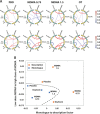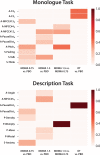Detection of acute 3,4-methylenedioxymethamphetamine (MDMA) effects across protocols using automated natural language processing
- PMID: 31978933
- PMCID: PMC7075895
- DOI: 10.1038/s41386-020-0620-4
Detection of acute 3,4-methylenedioxymethamphetamine (MDMA) effects across protocols using automated natural language processing
Abstract
The detection of changes in mental states such as those caused by psychoactive drugs relies on clinical assessments that are inherently subjective. Automated speech analysis may represent a novel method to detect objective markers, which could help improve the characterization of these mental states. In this study, we employed computer-extracted speech features from multiple domains (acoustic, semantic, and psycholinguistic) to assess mental states after controlled administration of 3,4-methylenedioxymethamphetamine (MDMA) and intranasal oxytocin. The training/validation set comprised within-participants data from 31 healthy adults who, over four sessions, were administered MDMA (0.75, 1.5 mg/kg), oxytocin (20 IU), and placebo in randomized, double-blind fashion. Participants completed two 5-min speech tasks during peak drug effects. Analyses included group-level comparisons of drug conditions and estimation of classification at the individual level within this dataset and on two independent datasets. Promising classification results were obtained to detect drug conditions, achieving cross-validated accuracies of up to 87% in training/validation and 92% in the independent datasets, suggesting that the detected patterns of speech variability are associated with drug consumption. Specifically, we found that oxytocin seems to be mostly driven by changes in emotion and prosody, which are mainly captured by acoustic features. In contrast, mental states driven by MDMA consumption appear to manifest in multiple domains of speech. Furthermore, we find that the experimental task has an effect on the speech response within these mental states, which can be attributed to presence or absence of an interaction with another individual. These results represent a proof-of-concept application of the potential of speech to provide an objective measurement of mental states elicited during intoxication.
Figures




References
-
- Bird S, Klein E, Loper E. Natural language processing with python: analyzing text with the natural language toolkit. 2009. 10.1097/00004770-200204000-00018.
-
- Neustein A. Advances in speech recognition: mobile environments, call centers and clinics. 2010. 10.1007/978-1-4419-5951-5.
Publication types
MeSH terms
Substances
Grants and funding
LinkOut - more resources
Full Text Sources
Medical

